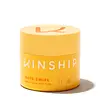What's inside
What's inside
 Key Ingredients
Key Ingredients

 Benefits
Benefits

 Concerns
Concerns

 Ingredients Side-by-side
Ingredients Side-by-side

Water
Skin ConditioningGlycolic Acid
BufferingGlycerin
HumectantMalic Acid
BufferingAloe Barbadensis Leaf Juice
Skin ConditioningSalix Alba Bark Extract
AstringentLactobacillus Ferment
Skin ConditioningAnanas Sativus Fruit Extract
Skin ConditioningCaprylic/Capric Triglyceride
MaskingCitrus Limon Peel Oil
MaskingCitrus Limon Fruit Extract
MaskingHoney Extract
HumectantRose Extract
Skin ConditioningTheobroma Cacao Extract
Skin ConditioningVitis Vinifera Fruit Extract
Skin ConditioningSodium Hydroxide
BufferingCaprylyl/Capryl Glucoside
CleansingPhenoxyethanol
PreservativeEthylhexylglycerin
Skin ConditioningWater, Glycolic Acid, Glycerin, Malic Acid, Aloe Barbadensis Leaf Juice, Salix Alba Bark Extract, Lactobacillus Ferment, Ananas Sativus Fruit Extract, Caprylic/Capric Triglyceride, Citrus Limon Peel Oil, Citrus Limon Fruit Extract, Honey Extract, Rose Extract, Theobroma Cacao Extract, Vitis Vinifera Fruit Extract, Sodium Hydroxide, Caprylyl/Capryl Glucoside, Phenoxyethanol, Ethylhexylglycerin
Water
Skin ConditioningDipropylene Glycol
HumectantGlycereth-26
HumectantNiacinamide
SmoothingGlycerin
Humectant1,2-Hexanediol
Skin ConditioningDiphenyl Dimethicone
EmollientTriethylhexanoin
MaskingHydroxyacetophenone
AntioxidantHydrogenated Lecithin
EmulsifyingPolyglyceryl-10 Oleate
Skin ConditioningCentella Asiatica Extract
CleansingDipotassium Glycyrrhizate
HumectantSodium Citrate
BufferingAllantoin
Skin ConditioningOctyldodeceth-16
EmulsifyingCitric Acid
BufferingDisodium EDTA
Polyglyceryl-10 Laurate
Skin ConditioningJuniperus Virginiana Oil
MaskingButylene Glycol
HumectantArtemisia Vulgaris Oil
PerfumingPogostemon Cablin Leaf Oil
MaskingMadecassoside
AntioxidantRosmarinus Officinalis Leaf Oil
MaskingViola Odorata Leaf Extract
MaskingCentella Asiatica Root Extract
Skin ConditioningCentella Asiatica Leaf Extract
Skin ConditioningSaccharomyces Ferment
Skin ConditioningMangifera Indica Fruit Extract
Skin ConditioningLactobacillus Ferment
Skin ConditioningAsiaticoside
AntioxidantMadecassic Acid
Skin ConditioningAsiatic Acid
Skin ConditioningWater, Dipropylene Glycol, Glycereth-26, Niacinamide, Glycerin, 1,2-Hexanediol, Diphenyl Dimethicone, Triethylhexanoin, Hydroxyacetophenone, Hydrogenated Lecithin, Polyglyceryl-10 Oleate, Centella Asiatica Extract, Dipotassium Glycyrrhizate, Sodium Citrate, Allantoin, Octyldodeceth-16, Citric Acid, Disodium EDTA, Polyglyceryl-10 Laurate, Juniperus Virginiana Oil, Butylene Glycol, Artemisia Vulgaris Oil, Pogostemon Cablin Leaf Oil, Madecassoside, Rosmarinus Officinalis Leaf Oil, Viola Odorata Leaf Extract, Centella Asiatica Root Extract, Centella Asiatica Leaf Extract, Saccharomyces Ferment, Mangifera Indica Fruit Extract, Lactobacillus Ferment, Asiaticoside, Madecassic Acid, Asiatic Acid
 Reviews
Reviews

Ingredients Explained
These ingredients are found in both products.
Ingredients higher up in an ingredient list are typically present in a larger amount.
Glycerin is already naturally found in your skin. It helps moisturize and protect your skin.
A study from 2016 found glycerin to be more effective as a humectant than AHAs and hyaluronic acid.
As a humectant, it helps the skin stay hydrated by pulling moisture to your skin. The low molecular weight of glycerin allows it to pull moisture into the deeper layers of your skin.
Hydrated skin improves your skin barrier; Your skin barrier helps protect against irritants and bacteria.
Glycerin has also been found to have antimicrobial and antiviral properties. Due to these properties, glycerin is often used in wound and burn treatments.
In cosmetics, glycerin is usually derived from plants such as soybean or palm. However, it can also be sourced from animals, such as tallow or animal fat.
This ingredient is organic, colorless, odorless, and non-toxic.
Glycerin is the name for this ingredient in American English. British English uses Glycerol/Glycerine.
Learn more about GlycerinLactobacillus Ferment is created by fermenting the Lactobacillus bacteria. It helps keep our skin's natural barrier and microbiome healthy.
Studies show lactobacillus ferment to be effective at repairing the skin barrier. Having a healthy skin barrier helps keep your skin healthy and hydrated. It also protects against bad bacteria.
As a probiotic/prebiotic/postbiotic, Lactobacillus ferment can help regular our natural biome. In fact, one study found a lack of diversity in our natural skin biome can trigger acne.
Learn more about Lactobacillus FermentWater. It's the most common cosmetic ingredient of all. You'll usually see it at the top of ingredient lists, meaning that it makes up the largest part of the product.
So why is it so popular? Water most often acts as a solvent - this means that it helps dissolve other ingredients into the formulation.
You'll also recognize water as that liquid we all need to stay alive. If you see this, drink a glass of water. Stay hydrated!
Learn more about Water